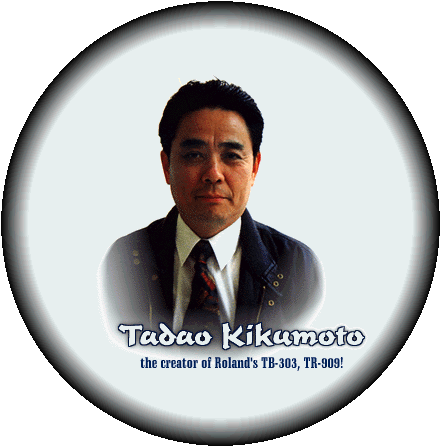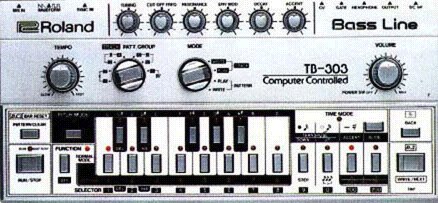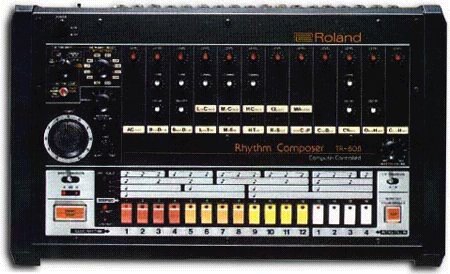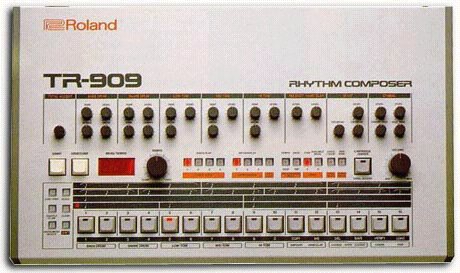
Ah, these fabled vintage machines have changed and set the standard for dance music.
Launched over 15 years ago, and some of them even more, these analogue monsters are still highly in demand and usage. They were expensive enough back then, but nowadays the are gold dust!
The Roland Corporation has vowed never to manufacture these modules again, no matter what. Pity really, ‘cause they would make a fortune! Anyway, here is a little bit of history…

- The TB-303 Computer Controlled Bassline
Some numbers:
- Less than 20'000 were made.
- Total manufacturing time: about 18 months.
- Original price: $395!
- Ram chips : Nec's µPD-444C CMOS RAM, 1024 x 4 Bit Static
- CPU type: Nec's µPD-650C-133, 4-bit microcomputer. (133 stands for Roland's identification internal firmware Rom code)
So why is it such a cult machine? Good question! Because it's EASY to use: the sequencer is a random tool and features the unique per-note slide option (portamentto without retrig), and you dont have to get rid of patch cords all around to create something basic ... The sound itself is also a monster: unbeatable 18db filter (some said it was in fact 24db...), from deep bass bangs to crying acid screams ... NASTY !!!
And now it's time for a small story:
The TB-303 (btw. TB stands for Transistor Bass as TR for Transistor Rhythm) was released back in 1982 together with the TR-606 analog drum machine. This pack was intended to emulate a drummer and a bassist (!!!) but the sounds were so poor that none wanted to work with those kid's toys ! 7 years later a guys called DJ PIERRE had the idea to turn the knobs while playing the 303: acid house was born ! 7 years more and this gear is now one of the most wanted synth of the techno production, together with the TR-909 drum machine.
Expect to pay £500-£1500 depending!

- The TR-808 Rhythm Composer
Internal sound source:
16 analog drum sounds (BD, SD, Low,Mid,Hi Tom/Conga, Claves,Rim, Maracas, HC, Cow bell, Cymbal, O/C HH.
Inputs:
2xPEDAL (Start/Stop, Fill-In), 1xDin Sync IN/OUT (operation selected via a switch on back of unit)
Outputs:
2xMix, 11xindividual, 3xTrig, Shared Din Sync (see above)
Synchronization possibilities:
Din Sync.
Secondary data storage:
None. (Well, at least the memory is battery-backed so you don't lose your work when the machine is switched off...)
Memory size:
12 patternsx32 steps, 4 fill-in pat, 12 tracksx64 meas.
Physical size:
508x305x105 mm, 5 kg (!)
Data generation/modification/recording:
Internal-only sequencer programmable in step or real time. Trigs it’s own internal sounds, or three external sounds/devices through voltage spikes.
Bugs & Features:
The sequencer is archaic but functional. Instruments are selected with a rotary knob and programmed via 16 multi-colored buttons with built-in LEDs. The "real-time" mode is reminiscent of the TB-303: an instrument is assigned to the dedicated "tap-button" which can be used to trigger and record the sound when the pattern is playing!
The sounds are analog and editable via knobs and for us knob-twiddlers the later SP non-tweakable drum machines seem like a step backwards in evolution. Also the idea of dedicated fill-in patterns that can be automatically trigged every n-th round or manually via a button or pedal is quite neat. Individual outputs are also on the plus side.
Tips & Tricks:
The 'erase' button means other less destructive things when in other modes. Also, the manual fill-in doesn't always fill in in a predictable manner. Beware! This unit is ANALOG and UNPREDICTABLE :-). There exist numerous mods for this machine, allowing it to sync and perform via MIDI. The most noteworthy being the Kenton kit, which allows the drum, sounds to receive MIDI velocity as well.
